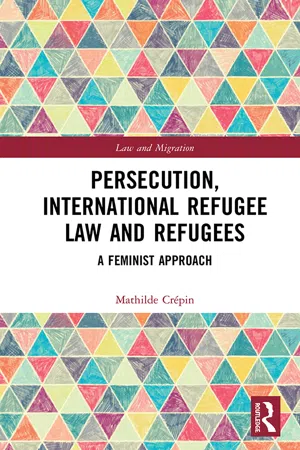1.1.1 Legal developments and the progressive conceptualisation of who is a refugee in international law
The concept of asylum is an old concept, dating back to antiquity5 and consisting in the right of a state to grant asylum to individuals at risk of political or religious oppression. This right was for a long time the prerogative of recipient states and merely constituted an individual and political choice of the host country.6 As a result, no coordinated plan of action existed at a regional or international level to address the plight of displaced individuals. It should be noted that prior to the 20th century, the ambit of displacements and migration was relatively modest, with a limited global impact. As such, there were very few incentives for states to develop a common system of protection. One of the first and largest displacements of population across nation states only occurred in 1685 when the French King Louis XIV made the practice of protestant faith illegal in France. As a result, protestant Huguenots fled in masse to neighbouring countries, seeking shelter in today’s Germany, the Netherlands, Switzerland and other European states.7 At that time, it was estimated that over 200 000 individuals were displaced in the space of two decades8 and the protection responses provided by European states were based on the discretionary decisions of the reigning powers.
During World War I, much larger movements of population took place on the European continent.9 Given the high risk of destabilisation in the region, European countries decided for the first time to adopt a number of common agreements in order to better organise the delivery of aid. New instruments were developed under the auspices of the League of Nations, to determine who was eligible for refugee status by referring to specific categories of people. For instance, a number of bilateral and multilateral treaties were created to protect individuals who had fled the consequences of the Russian revolution in 1917 and the problems arising out of the dissolution of the Ottoman Empire.10 Some other treaties covered different groups such as ‘Latvian refugees (…) in the territory of Ukrainian Socialist Soviet Republic’,11 ‘Greek refugees’,12 ‘refugees in Bulgaria’,13 ‘refugees coming from Germany’.14 In these instruments, refugee law was understood as a response to the plight of certain categories of people fleeing repressive state policies. It can be observed that, in this period, the notion of persecution was not mentioned in any of the League of Nations’ documents because refugees were categorised as specific groups of individuals depending on their origins. Some authors such as Zarjevski highlighted the fact that this approach was quite restrictive because it was limited ‘to precisely describe already existing categories of people’15 and did not rely on a generic definition.
5 Gy Haraszti, ‘The Right of Asylum’ [1960] 2 Acta Juridica 359, 361.
6 Ibid. 363: ‘In the first place, let us point out that the right of asylum is the right of the State to grant asylum to persons prosecuted for political reasons. This right resulting from state sovereignty is recognized by international customary law and is a constituent of several international agreements as well.’
7 See analysis of Owen Stanwood, ‘Between Eden and Empire: Huguenot Refugees and the Promise of New Worlds’ [2013] 118 The American Historical Review 1319. DOI: 10.1093/ahr/118.5.1319
8 Ibid. 1319.
9 Up to 9.5 millions in Peter Gatrell, ‘World Wars and Population Displacement in the Twentieth Century’ [2007] 16 Contemporary European History 415, 418. DOI: https://doi.org/10.1017/S0960777307004092.
10 Inter alia, ‘Arrangement with respect to the issue of certificates of identity to Russian Refugees’, signed at Geneva, 5 July 1922 League of Nations Treaty Series (LNTS) [1922], vol 13, 237–257; ‘Arrangement concerning the Extension to other Categories of Refugees of certain Measures taken in favour of Russian and Armenian Refugees’, signed at Geneva, 30 June 1928, League of Nations Treaty Series (LNTS) [1929], vol 89, 47–52.
11 ‘Agreement regarding the repatriation of Latvian refugees who are at present in the territory of Ukrainian Socialist Soviet Republic’, signed at Moscow, 3 August 1921 League of Nations Treaty Series (LNTS) [1923], vol 17, 306–315
12 Inter alia, ‘Declaration relating to the settlement of Refugees in Greece and the creation for this purpose of a Refugees Settlement Commission’ signed in Geneva, 29 September 1923 League of Nations Treaty Series (LNTS) [1923], vol 20,41–43; ‘Protocol relating to the settlement of Refugees in Greece and the creation for this purpose of a Refugees Settlement Commission’, signed in Geneva, 29 September 1923 League of Nations Treaty Series (LNTS) [1923], vol 20, pp. 29–39; ‘Additional Act to the Protocol of September 29, 1923, relating to the Settlement of Greek Refugees’.
13 ‘Protocol concerning the Settlement of Refugees in Bulgaria’ signed in Geneva, 8 September 1926 [1926], League of Nations Treaty Series (LNTS), vol 58, 245–257.
14 Inter alia, ‘Provisional Arrangement concerning the Status of Refugees coming from Germany, and Annex’, signed in Geneva, 4 July 1936 League of Nations Treaty Series (LNTS) [1936], vol 171, 75–87; ‘Convention concerning the Status of Refugees coming from Germany, with Annex’, signed in Geneva, 10 February 1938 League of Nations Treaty Series (LNTS), vol 192, 59–81.
15 Delphine Zarjevski, A Future Preserved, International Assistance to Refugees (Pergamon Press 1988) 12.
The League of Nations was eventually dissolved at the outset of World War II and, as new groups of refugees appeared, the old refugee treaties became obsolete. Just before the beginning of World War II and in the aftermath of the Allies’ victory, the international community successively created the Intergovernmental Committee on Refugees (ICR) in 1938, the United Nations Relief and Rehabilitation Administration (UNRRA) in 1943 and the International Refugee Organisation (IRO) in 1946 in order to provide assistance to refugees. These entities adopted new approaches to international aid. The first organisation, the ICR, was in charge of facilitating the emigration of victims of the Nazi regime from Germany and Austria and considered that only individuals from these countries were entitled to receive international protection.16 This new approach was rather inn...
